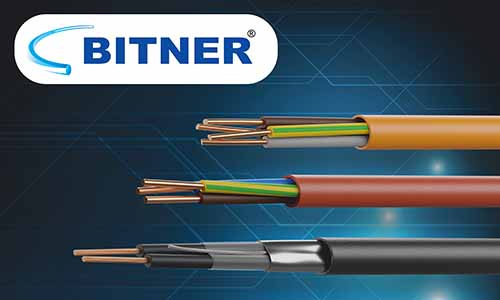A number of new solutions from Bitner, a Polish manufacturer of high-end cabling, have recently been added to the TME catalogue. These are products dedicated mainly to industrial installations – characterized by excellent oil, moisture, UV radiation, and, above all, flame retardance properties. Below we describe the characteristics of the individual product groups and series – all those interested in cables for alarm installations in industry and construction can learn more about the extended offer.
Cables for alarm and fire protection systems
Cables for alarm systems require better resistance to thermal and mechanical factors than ordinary signal cables. The products offered in this group belong to several series, including those described below. First of all, they can perform various functions – communication (transmission of sensor data), signalling (e.g. fire alarm), and power supply (lighting, fire protection equipment, and pumps). Bitner’s offer includes products designed to perform these functions. These include both single- and multicore (up to 10 cores) cables. The conductors have cross-sections of up to 240 mm2. As this cabling is sometimes laid with other elements of the communication infrastructure, the manufacturer has prepared shielded variants, which limit the impact and emission of electromagnetic interference. Insulating materials used in the cables include PVC, XLPE (cross-linked polyethylene) and LSZH materials (low smoke, zero halogen, i.e. emitting a small amount of halogen-free gases during a fire). Under regular operating conditions, the operating temperature of the cables ranges from -40°C to 90°C (selected models).
Conductors are colour-coded according to standard colour code for network cables.
The cables meet several requirements according to international standards. E90 cables maintain circuit continuity under fire conditions in accordance with DIN4102-12 and PN-EN 50200 (PH120) standards. The flame propagation resistance of the cable is determined in accordance with PN-EN/IEC 60332-1 and VDE 0482-332-1. Flame propagation test: PN-EN/IEC 60332-3-24 and VDE 0482-332-3-24. The smoke density during combustion is determined according to PN-EN/IEC 602754-2, PN-EN/IEC 61034-2, VDE 0482-754-2, and VDE 0482-1034-2 standards.
Selected Bitner cables meet the requirements of FE180, PH90, and PH120 – therefore, they can maintain electrical continuity under fire conditions. They are therefore excellent for alarm installations in public buildings (schools, railway stations, or airports) as well as hotels, offices, cinemas, etc.
BiT 500 (St) BLACK FR series
BiT 500 cables have a metallized film and a grounding wire.
The BiT series is an example of combining high flame resistance with functionality. These cables are dedicated to control applications. Under a PVC sheath and an aluminium-coated PET film layer, they have up to 48 copper-stranded conductors. At the same time, they are class 5 flexible conductors: bending radius is 6 times the cable diameter (for permanently installed systems); cable diameter ranges from 7 mm to 20.9 mm. This depends on the number and cross-sections of cores (from 0.5mm2 to 1.5mm2). The cables are allowed for moving use. These cables can be laid underground as well as outdoors and are oil and moisture resistant; therefore, they are suitable for use in industrial facilities. Additionally, due to the use of a flame retardant coating, they do not propagate flames, allowing them to be used in facilities with increased fire protection requirements .
BiTflame 1000 series
BiTflame 1000 cables, one of the new additions to the TME range, are an example of durable products that meet the standards described above. They are E90 cables, i.e. they will maintain circuit continuity under fire conditions for at least 90 minutes . Furthermore, the cables can be used both indoors and outdoors; their outer sheath is UV-resistant. The design of the cables also allows them to be used in spaces protected by fire-extinguishing systems.
Double protective sheath for high cable resistance.
The cables come with 1 to 7 solid or stranded wires with a cross-section of 1.5…240 mm2. Individual conductors are colour-coded. The outer diameter of BiTflame 1000 cables ranges from 10.4mm to 30.3mm. The operating voltage of the cables is 0.6/1kV. Thus, they have been adapted to a range of industrial and power supply applications, while maintaining high safety standards in emergencies.
HDGs series
The colour code of the insulation distinguishes the cables in the cable bundle.
The HDGs range has similar flame retardant properties to the BiTflame 1000 and also belongs to the group of electrical products (at 300/500V). However, the cables have smaller outer diameters, from 6.7mm, and are designed for use in buildings. They contain from 2 to 5 copper wire cores. They can be laid at low temperatures, even at -10°C. They are mainly dedicated to fire automation, emergency lighting installations, etc. Their sheathing is made in a distinctive red colour, so they will stand out in cable bundles.
BiTinstal H series
BiTinstal H cables are characterised by a wide operating temperature range under normal conditions (from -40°C to 90°C). In addition, they are B2ca class cables, so they can be used in facilities with stringent fire safety requirements, including escape routes, increasing people’s safety during firefighting and evacuation of the building. These cables are designed to be laid permanently, in walls (directly in concrete), ducts, and cable pipes. Their wires (up to 5) have typical colour-coding for AC wiring (black, grey, brown, blue, and yellow-green).
The cables are stranded-conductor cables dedicated to permanent installation.
XzTKMXpw telecommunication cables
XzTKMXpw cables are designed for telecommunication local area networks and industrial installations. These are aluminium foil or metallised film shielded cables, with cores (up to 10) made in the form of copper wire with a cross-section of 0.5mm2 or 0.8mm2. Thanks to the outer sheath made of polyethylene, they can be laid directly in the ground, as well as installed outside (UV resistance and additional protection against moisture penetration are provided by a double-sided copolymer coated aluminium tape and a hydrophobic gel filling). Individual conductors are bundled together and then layered, improving the communication properties and making it easier to identify wires.













